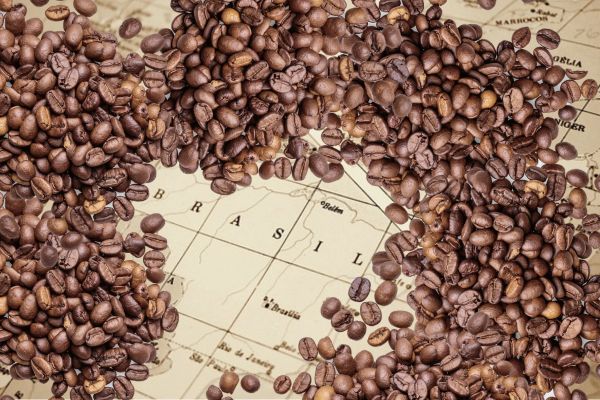Coffee is a drink that is part of the lives of millions of Brazilians, whether at breakfast, at work break or at chat time with friends. But do you know how coffee came to Brazil and how it became one of the main products of our economy and our cultural identity?
The origin of coffee
Coffee originated in Ethiopia, in Africa, where it was consumed by shepherds who noticed its stimulating effects. From Africa, coffee spread to Arabia, where it was cultivated and traded by the Arabs from the 14th century. From there, coffee was taken to Europe, where it became popular in the 17th and 18th centuries.
Coffee in Brazil
Coffee arrived in Brazil in 1727, brought by the military Francisco de Melo Palheta, who obtained some seeds in French Guiana. The first seedlings were planted in Pará and then taken to other regions of the country.
The coffee cycle
Coffee became the main product of the Brazilian economy in the 19th century, replacing sugar and cotton. The coffee cycle began in the Paraíba Valley, between Rio de Janeiro and São Paulo, where the crops were based on slave labor.
With the abolition of slavery and the crisis of the valley, coffee expanded to the west of São Paulo, where immigrant labor predominated, mainly Italian.
Coffee was responsible for social, political and cultural transformations in Brazil. It boosted industrialization, urbanization, railway construction, immigration and modernization of the country. It also gave rise to the coffee elite, which dominated national politics in the Old Republic.
The culture of coffee
Coffee is not only an economic product, but also a cultural element of Brazil. It is present in gastronomy, art, music, literature and everyday life of Brazilians. It is a symbol of hospitality, sociability and brazilianity.
Coffee is a drink that can be enjoyed in different ways: filtered, espresso, cappuccino, mocha, iced etc. It can also be harmonized with different foods and drinks. It is a source of energy, pleasure and inspiration.
The universe of coffee is vast and inviting. Enjoy!
The types of Brazilian coffee
Brazil is the largest producer and exporter of coffee in the world, with a diversity of types and flavors that cater to different tastes. There are two main species of coffee beans: arabica and robusta.
Arabica is the most cultivated in Brazil, representing about 75% of national production. It adapts better to regions with high altitude and mild climate. It produces a smoother, more aromatic and complex drink, with balanced acidity and natural sweetness.
Robusta is more cultivated in Espírito Santo and Rondônia, representing about 25% of national production. It adapts better to regions with low altitude and hot and humid climate. It produces a stronger, fuller-bodied and bitter drink, with more caffeine and less sugar.
Within these two species, there are several varieties or cultivars of coffee, which are the result of natural or induced genetic crosses by producers. Each variety has its own characteristics of plant size, productivity, resistance to pests and diseases and quality of the drink.
Some of the best known varieties are:
Bourbon: originating from Bourbon Island (now Reunion), in Africa, it is one of the oldest and noblest varieties of arabica. It has red or yellow beans that produce a sweet, fruity and balanced drink.
Catuaí: originating from Brazil, it is a variety of arabica resulting from the crossing between the varieties Novo Mundo and Caturra. It has red or yellow beans that produce a light, smooth and medium-acid drink.
Catucaí: originating from Brazil, it is a variety of arabica resulting from the natural crossing between the varieties Catuaí and Icatu. It has red or yellow beans that produce a drink with similar characteristics to Catuaí.
Icatu: originating from Brazil, it is a hybrid variety of arabica resulting from the crossing between a plant of robusta and one of Bourbon Vermelho. It has red or yellow beans that produce a drink with intense aroma and citric acidity.
Acaiá: originating from Brazil, it is a variety of arabica derived from the variety Mundo Novo. It has large and round beans that produce a full-bodied drink with caramel notes.
Mundo Novo: originating from Brazil, it is a variety of arabica resulting from the natural crossing between the varieties Bourbon and Typica. It has large and elongated beans that produce a drink with velvety body and chocolate flavor.
Obatã: originating from Indonesia, it is a variety of arabica adapted to Brazil. It has red or yellow beans that produce a drink with floral and fruity aroma and citric acidity.
The quality of Brazilian coffee
Brazilian coffee is recognized worldwide for its quality and diversity. To ensure the excellence of the drink, there are several criteria and standards that evaluate the physical and sensory characteristics of the beans and the drink.
One of the main bodies responsible for this evaluation is the Brazilian Association of Coffee Industry (ABIC), which created the Coffee Quality Program (PQC), which classifies coffees into four categories: traditional, superior, gourmet and special.
Traditional coffee is the most common in the market, has minimum acceptable quality and simple flavor. Superior coffee has quality above average and more pleasant flavor. Gourmet coffee has excellent quality and refined flavor. Special coffee has exceptional quality and unique flavor.
In addition, there are other entities that certify special coffees, such as the Brazilian Association of Special Coffees (BSCA), the Specialty Coffee Association (SCA) and the Alliance for Coffee Excellence (ACE). These entities use rigorous criteria to evaluate coffees, such as origin, variety, post-harvest process, roast, aroma, flavor, acidity, body, sweetness, uniformity, balance and absence of defects.
Special coffees are those that score above 80 points on a scale of 0 to 100. They are produced with special care in all stages of the production chain, from planting to consumption. They express the maximum potential of each origin and variety.
The consumption of Brazilian coffee
Brazil is not only the largest producer and exporter of coffee in the world, but also one of the largest consumers. According to ABIC, domestic consumption of coffee in Brazil in 2020 was 21 million bags of 60 kg, which represents a per capita consumption of 6 kg per year.
Coffee is the second most consumed drink by Brazilians, losing only to water. It is present in all regions of the country and at all times of the day. It is mainly consumed in filtered or espresso form.
However, in recent years, there has been an increase in demand for differentiated coffees, such as special coffees, organic coffees, flavored coffees and soluble coffees. These coffees offer new sensory experiences to consumers.
The benefits of coffee for health
Coffee is a drink rich in chlorogenic acid, caffeic acid and kahweol, which are bioactive compounds with antioxidant properties that help fight free radicals, preventing premature aging, cancer, depression and diabetes.
In addition, coffee has great amounts of caffeine, a compound that stimulates the central nervous system, helping to combat depression, improving mood and physical and mental disposition.
Some of the benefits achieved with moderate consumption of coffee for health are:
1. Improves memory and concentration
Because it is rich in caffeine, a compound that stimulates the central nervous system,
coffee helps to improve memory and alertness, as well as increasing concentration
and reducing sleepiness.
However, tolerance to caffeine effects is very common,
that is, it is often necessary to consume increasingly higher doses to obtain
the same benefits that were obtained by consuming small initial doses.
2. Prevents depression
The polyphenols present in great amounts in coffee fight free radicals and reduce inflammation in the cells of the central nervous system, which contributes to reduce anxiety and improve mood, preventing depression.
In addition, coffee consumption is usually also associated with social habits of coexistence, stimulating contact with other people and favoring general well-being.
3. Prevents câncer
Coffee contains caffeine, chlorogenic acid, caffeic acid and kahweol, antioxidants that protect cells against damage caused by free radicals, preventing the development of some types of cancer. In addition, coffee helps to lower estrogen levels in the body, a hormone related to some types of cancer, such as breast, liver, colon and endometrial cancer.
4. Helps fight headaches
Coffee has anti-inflammatory and analgesic properties that help reduce and prevent headaches, including migraines.
However, some people who stop consuming coffee may notice improvements in headache.
This happens because the effects of the drink vary according to each organism.
Therefore, it is important to observe if coffee intake causes headache or helps improve symptoms.
5. Helps with weight loss
Coffee consumption favors weight loss, as caffeine helps control hunger temporarily, contributing to reducing food intake. In addition, coffee has thermogenic properties, increasing energy expenditure and fat burning, favoring weight loss.
In conclusion
Therefore, coffee is a beverage that brings numerous benefits to the health, economy, and culture of Brazil. It is a source of antioxidants, caffeine, and other nutrients that help prevent and combat various diseases, as well as improve mood, memory, and physical and mental performance.
It is also a product that generates employment, income, and development for the country, being the largest producer and exporter of coffee worldwide. Additionally, it is an element that is part of the identity and sociability of Brazilians, who appreciate the drink in different forms and moments.
Coffee is a national passion that has a rich and fascinating history. How about learning more about the different types of Brazilian coffee and their characteristics? Or visiting the historic farms where coffee was cultivated?
Or even trying delicious recipes that include coffee as an ingredient? The world of coffee is vast and inviting.
Enjoy!



